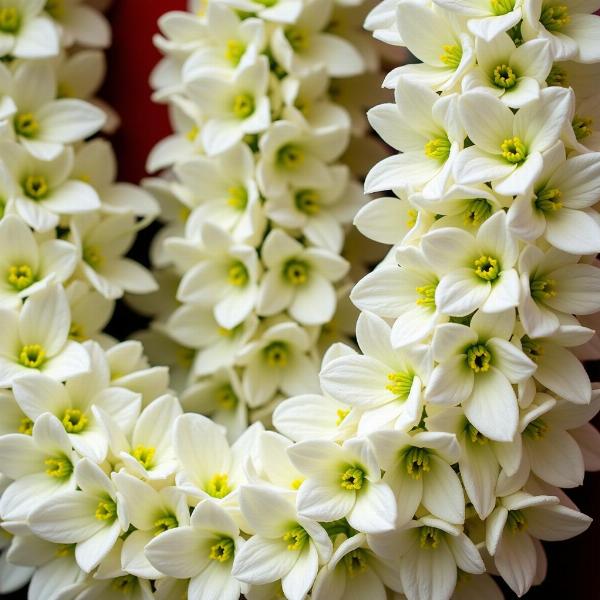Knowing the names of flowers in both English and Hindi can be incredibly enriching, especially if you live in India or are interested in Indian culture. Whether you’re trying to identify a beautiful bloom in your garden, learning Hindi, or simply expanding your vocabulary, this list of 10 common flowers with their names in English and Hindi will be a valuable resource. This guide provides not just the translations, but also insights into their cultural significance and practical uses, helping you appreciate these natural wonders even more.
Rose (Gulab) – A Timeless Symbol of Love
The rose, known as “gulab” (गुलाब) in Hindi, reigns supreme as a symbol of love and beauty across cultures. From vibrant reds to delicate pinks and pristine whites, roses are cherished for their fragrance and aesthetic appeal. They are frequently used in perfumes, religious ceremonies, and traditional Indian weddings.
Lotus (Kamal) – A Sacred Flower in Hinduism
The lotus, or “kamal” (कमल) in Hindi, holds deep spiritual significance in Hinduism and Buddhism. Representing purity, enlightenment, and rebirth, it is often depicted in religious art and literature. Its ability to emerge pristine from muddy waters symbolizes the triumph of the spirit over adversity. Besides its spiritual importance, the lotus is also used in traditional medicine and cuisine.
Jasmine (Chameli) – The Queen of Fragrance
With its intoxicating scent, jasmine, or “chameli” (चमेली) in Hindi, is highly prized in India. Its delicate white flowers are often strung into garlands, used in religious offerings, and woven into the hair of women. Jasmine oil is a key ingredient in perfumes and aromatherapy, known for its calming and uplifting properties.
 Jasmine (Chameli) flowers used in a garland
Jasmine (Chameli) flowers used in a garland
Marigold (Genda) – An Auspicious Flower for Celebrations
The vibrant orange and yellow marigold, or “genda” (गेंदा) in Hindi, is a staple in Indian festivals and ceremonies. Considered auspicious and symbolic of good fortune, it is commonly used in decorations, garlands, and religious offerings. Marigolds also have medicinal properties and are used in traditional remedies.
Sunflower (Surajmukhi) – Following the Sun’s Journey
Known as “surajmukhi” (सूरजमुखी) in Hindi, meaning “sun-faced,” the sunflower is admired for its bright yellow petals and its unique ability to track the sun’s movement across the sky. It is a source of edible seeds and oil, and its vibrant blooms add a touch of cheer to any garden.
Hibiscus (Gudhal) – A Versatile Flower with Cultural Significance
The hibiscus, called “gudhal” (गुड़हल) in Hindi, is a large, showy flower found in various colors. Used in religious rituals, it also has medicinal properties and is used to make teas and hair care products. Its vibrant petals add a splash of color to gardens and are sometimes used in culinary dishes.
Lily (Lili) – Elegance and Purity
The lily, known simply as “lili” (लिली) in Hindi, represents purity, innocence, and elegance. Its fragrant, trumpet-shaped flowers are popular in bouquets and floral arrangements. Different varieties of lilies hold symbolic meaning in various cultures. They also find mention in several mythological stories.
Tulip (Tulip) – A Symbol of Perfect Love
The tulip, retaining its English name “tulip” (ट्यूलिप) in Hindi, symbolizes perfect love and enduring affection. Its vibrant, cup-shaped flowers add a touch of elegance to any garden or floral arrangement. They are also a representation of cheerful thoughts and happy moments.
Daisy (Glebreda) – A Symbol of Innocence and Simplicity
Known as “glebreda” (ग्लेब्रेडा), though also referred to as “daisy” in Hindi, this charming flower represents innocence, simplicity, and new beginnings. Its cheerful white petals and bright yellow center bring a touch of joy to fields and gardens. They are perfect for those who wish to portray cheerful innocence.
Chrysanthemum (Shevanti) – A Flower of Many Meanings
The chrysanthemum, or “shevanti” (शेवंती) in Hindi, holds various meanings across cultures, including longevity, joy, and optimism. Its vibrant blooms come in a wide range of colors and forms, making them a popular choice for gardens and floral arrangements. They are especially appreciated for their ability to thrive in cooler temperatures.
Conclusion
Knowing the names of these 10 flowers in English and Hindi not only enhances your understanding of the natural world but also deepens your appreciation of Indian culture. Whether you’re a language enthusiast, a gardening enthusiast, or simply curious about the world around you, this knowledge will enrich your experience and open up new avenues of exploration. Remember these beautiful blooms and their significance the next time you encounter them!
FAQ
- What is the Hindi word for rose? The Hindi word for rose is “gulab” (गुलाब).
- What is the significance of the lotus flower in Hinduism? The lotus represents purity, enlightenment, and rebirth in Hinduism.
- Which flower is known as the “queen of fragrance” in India? Jasmine (chameli) is known as the “queen of fragrance.”
- What is the Hindi name for marigold? The Hindi name for marigold is “genda” (गेंदा).
- Which flower tracks the sun’s movement? The sunflower (surajmukhi) tracks the sun’s movement.
- What is the Hindi name for hibiscus? The Hindi name for hibiscus is “gudhal” (गुड़हल).
- What does the lily symbolize? The lily symbolizes purity, innocence, and elegance.
About Meaning-Hindi.in
Meaning-Hindi.in is your premier destination for professional Hindi translation services, catering to diverse needs from business and legal documents to technical manuals, website localization, and educational materials. We offer accurate, culturally sensitive translations across a wide range of specialized fields, ensuring your message resonates perfectly with your target audience. Contact us today for a free quote at [email protected] or call us at +91 11-4502-7584.